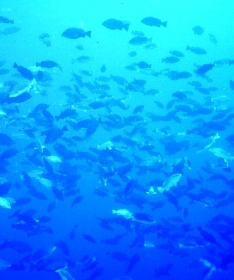Project tracks endangered ‘baby fish’ on first journey
 (CNS): Researchers working at the Reef Environmental Education Foundation (REEF) have launched a new website which is tracking this year’s Nassau grouper larvae as it makes its first journey through the treacherous oceans around the Cayman Islands. Baby Grouper Adrift! shows the results of state‐of‐the‐art satellite drifter research being conducted as part of the Grouper Moon Project, a collaborative research effort between REEF and the Department of the Environment (DoE). Working with scientists from Oregon State University, the Adrift project aims to better understand where the endangered grouper larvae will end up after being spawned – a key part of learning more about the fish and how to help protect them.
(CNS): Researchers working at the Reef Environmental Education Foundation (REEF) have launched a new website which is tracking this year’s Nassau grouper larvae as it makes its first journey through the treacherous oceans around the Cayman Islands. Baby Grouper Adrift! shows the results of state‐of‐the‐art satellite drifter research being conducted as part of the Grouper Moon Project, a collaborative research effort between REEF and the Department of the Environment (DoE). Working with scientists from Oregon State University, the Adrift project aims to better understand where the endangered grouper larvae will end up after being spawned – a key part of learning more about the fish and how to help protect them.
The scientists say that these endangered fish seem to choose the worst imaginable place in the ocean -cold and deep, with big waves meshing over the convergence of strong currents- to spawn on winter nights. They now hope to answer questions about why there and what is the importance of such places.
“For a long time, scientists thought fish spawned at these sites to spread larvae all over. Recent evidence, however, suggests that fish spawn at these sites, and at certain times of the day and tide cycle, in order to keep larvae close to home,” officials from REEF said.
With everyone wondering where the Cayman grouper larvae will end up through the Grouper Moon Project research efforts, visitors to the Adrift website can follow the larvae in real time as they complete a 45‐day ocean journey, and with any luck, make it back to Cayman’s coastal areas to settle and grow.
The researchers released satellite‐linked drifter buoys to track the eggs released at a Nassau grouper spawning site this season on the Island of Little Cayman. The Adrift webpage features a map that continually updates the location of these drifters as they are taken by the ocean currents along the potential route grouper larvae may take as they grow large enough to settle on the reef.
Once the larvae are a few days old they are able to move up and down in the water so they may be affected by different currents which means that the drifters can only estimate the likely route with their final destination still any one’s guess. As a result visitors to the website are being asked to do just that and submit a guess where they think the drifters will end up with the closest guess winning a prize.
The primary objective of the Grouper Moon Project is to evaluate the importance of Nassau grouper spawning aggregations to local fisheries and coral reef ecosystems. Little Cayman in the Cayman Islands is home to one of the last known, and largest, spawning aggregations of the endangered Nassau grouper.
For ten days following winter full moons, thousands of large grouper meet at known reef sites for short periods of time (days to weeks) and release their gametes in massive spawning bursts. Since 2002, REEF and DoE have coordinated annual efforts to monitor and study the Little Cayman Nassau grouper aggregation. The project has grown in scope to include an ambitious acoustic tagging research project, juvenile habitat and genetics studies, and oceanographic connectivity research.
For more information please visit the REEF website and click here to go to Baby Grouper Adrift!
Category: Science and Nature


Among the most photogenic of our reef fish, the groupers used to be the ambassadors of Grand Cayman’s dive sites, welcoming divers to return again and again from around the world. That was in the 60’s thru 80’s when the reef was packed with fish, before fishing the spawning grounds (grouper and snapper) finally cleared them from our reef. We have all lost income as a result of their demise, which has no doubt resulted in greatly reducing the number of divers making repeat visits here. Experienced divers now go to Little Cayman for that thrill, but even that is still threatened. We could be the diving Mecca once again if we just put tough limits on what we take fromthe reef. To ignore this problem now will cost each and every Caymanian $millions$ in lost potential future tourism revenue. We’ve already lost $millions$. How much more do you want to lose?
Don’t they go to the Mangroves that Mac want to destroy for Mega Yachts millionaires?
After they return, bo-bo. Life is complicated like that.